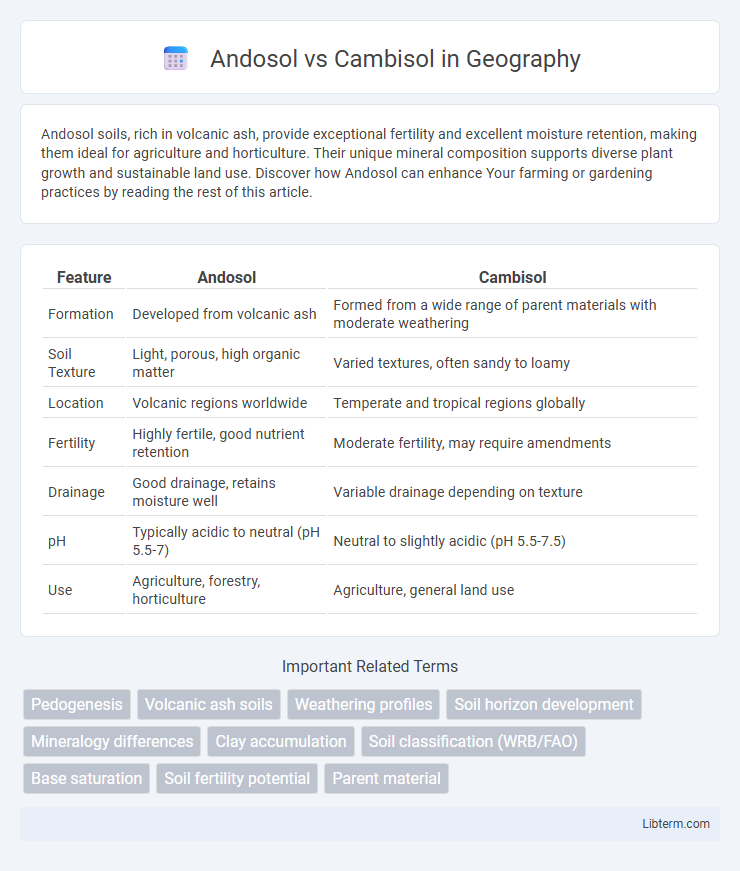Andosol soils, rich in volcanic ash, provide exceptional fertility and excellent moisture retention, making them ideal for agriculture and horticulture. Their unique mineral composition supports diverse plant growth and sustainable land use. Discover how Andosol can enhance Your farming or gardening practices by reading the rest of this article.
Table of Comparison
| Feature | Andosol | Cambisol |
|---|---|---|
| Formation | Developed from volcanic ash | Formed from a wide range of parent materials with moderate weathering |
| Soil Texture | Light, porous, high organic matter | Varied textures, often sandy to loamy |
| Location | Volcanic regions worldwide | Temperate and tropical regions globally |
| Fertility | Highly fertile, good nutrient retention | Moderate fertility, may require amendments |
| Drainage | Good drainage, retains moisture well | Variable drainage depending on texture |
| pH | Typically acidic to neutral (pH 5.5-7) | Neutral to slightly acidic (pH 5.5-7.5) |
| Use | Agriculture, forestry, horticulture | Agriculture, general land use |
Introduction to Andosol and Cambisol
Andosols are fertile soils formed from volcanic ash, characterized by high organic matter content and excellent water retention, making them ideal for agriculture in volcanic regions. Cambisols, on the other hand, are young soils with moderate horizon development, commonly found in temperate climates and often supporting diverse vegetation due to their balanced nutrient content. Both soil types play crucial roles in ecosystems, with Andosols contributing to high crop productivity and Cambisols facilitating sustainable land use in various environments.
Defining Andosol: Key Characteristics
Andosol is a volcanic ash-derived soil characterized by high organic matter content, strong phosphorus retention, and excellent water-holding capacity, often found in regions with recent volcanic activity. Its unique mineral composition includes allophane and imogolite, which contribute to its distinct dark color and high fertility. Cambisol, in contrast, is a more weathered soil with moderate horizon development, commonly found in diverse climatic zones and typically exhibiting lower nutrient retention than Andosol.
Cambisol Explained: Main Features
Cambisol soils are characterized by a well-developed but less distinct horizon differentiation compared to Andosols, typically formed under temperate or subtropical climates. They exhibit moderate to high fertility, with good structure and drainage, making them suitable for diverse agricultural practices. Cambisols often develop from various parent materials, showing properties such as a loamy texture, neutral to slightly acidic pH, and moderate organic matter content.
Formation Processes: Andosol vs Cambisol
Andosols form primarily from volcanic ash and pyroclastic materials, characterized by high organic matter content and unique allophane clay minerals resulting from rapid volcanic glass weathering. Cambisols develop through moderate weathering of a wide range of parent materials under varying climatic conditions, leading to significant horizon differentiation without intensive accumulation of organic or clay materials. The difference in formation processes reflects Andosol's volcanic origin and rapid mineral transformations, contrasting with Cambisol's broader geochemical alterations and soil profile development over time.
Physical Properties Comparison
Andosols exhibit high porosity and low bulk density due to their volcanic ash origin, promoting excellent water retention and aeration, unlike Cambisols, which have moderate porosity and higher bulk density reflecting their more weathered and mixed mineral content. Andosols typically show greater aggregate stability and lower plasticity, enhancing root penetration and reducing erosion risk compared to the more compact and less stable structure of Cambisols. The unique physical properties of Andosols support superior fertility and biological activity, while Cambisols offer better mechanical support but lower moisture retention capacity.
Chemical Properties Differences
Andosols exhibit higher organic carbon content and greater phosphorus retention due to abundant allophane and imogolite minerals, resulting in acidic pH and strong nutrient fixation. Cambisols present more balanced chemical properties with moderate cation exchange capacity (CEC) and neutral to slightly acidic pH, reflecting their mineral weathering status and lower organic matter. The distinct chemical composition influences soil fertility management, with Andosols requiring specific amendments to counteract nutrient immobilization, unlike Cambisols.
Geographic Distribution and Occurrence
Andosols are primarily distributed in volcanic regions such as the Pacific Ring of Fire, including parts of Japan, Indonesia, and the Pacific Northwest of the USA, formed from volcanic ash and characterized by high organic matter and mineral weathering. Cambisols occur widely across temperate, tropical, and subtropical zones, especially in Europe, North America, and parts of Africa and Asia, developing on varied parent materials with moderate horizon development. The geographic occurrence of Andosols is closely linked to recent volcanic activity, whereas Cambisols are common in landscapes with more stable geological conditions and widespread soil development.
Land Use and Agricultural Potential
Andosols, characterized by volcanic ash content, exhibit high fertility and excellent water retention, making them ideal for intensive agriculture, especially for crops like coffee, tea, and vegetables. Cambisols, with well-developed horizons and moderate nutrient availability, support diverse land uses including cereal cultivation and pasture, though their agricultural potential can vary with texture and organic matter content. Land use on Andosols often emphasizes sustainable practices due to their sensitivity to erosion, whereas Cambisols allow for more flexible management in temperate and tropical regions.
Environmental Impact and Soil Management
Andosols exhibit high organic matter content and excellent water retention, supporting carbon sequestration and reducing erosion risks, making them ideal for sustainable land use and environmental conservation. Cambisols, with moderate nutrient levels and better drainage, require careful management to prevent nutrient leaching and degradation, especially in intensive agriculture. Effective soil management strategies for Andosols include preserving organic layers and minimizing disturbance, while Cambisols benefit from crop rotation and organic amendments to maintain fertility and mitigate environmental impacts.
Summary: Choosing Between Andosol and Cambisol
Andosol and Cambisol soils differ primarily in origin and fertility, with Andosols formed from volcanic ash, exhibiting high organic matter and excellent water retention, making them ideal for agriculture. Cambisols develop from various parent materials, characterized by moderate fertility and well-structured horizons suitable for diverse crops and forestry. Selecting between Andosol and Cambisol depends on land use goals, soil fertility needs, and local environmental conditions.
Andosol Infographic

 libterm.com
libterm.com